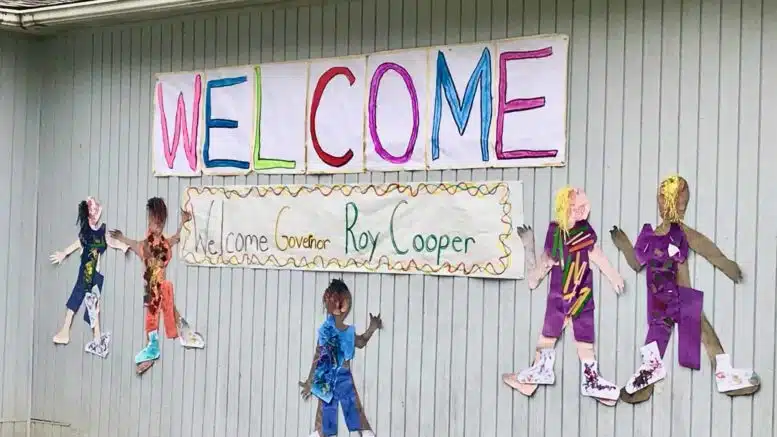By Jennifer Fernandez
Federal pandemic aid helped boost pay and increase benefits for the staff at Anna Mercer-McLean’s child care center in Carrboro.
Even as enrollment has increased since late 2021, when that aid first started coming in, staffing is down by two people, said Mercer-Mclean, director of Community School for People Under Six. She said she could really use more help.
“Hiring teachers is still an issue,” she said, noting that it is hard to find good teachers who are “dedicated and committed.”
That’s about to get even harder as the federal aid that gave people that boost dries up at the end of the year with not enough relief in sight to help, North Carolina child care advocates warn.
December deadline
A new national report shows the state of the child care system in North Carolina mirrors what’s happening across the country: low worker pay and high tuition negatively affect access to care and quality of care.
In North Carolina, federal pandemic funding from the American Rescue Plan Act, which went into effect in March 2021, helped child care providers boost pay and benefits and subsidized the cost of child care for many families.
But with pandemic concerns waning, that funding runs out in December. Advocates worry that access to child care — already an issue, especially in rural areas — will get worse.
“With those ARPA dollars running out we face this devastating funding cliff for which we really need a lot of attention,” said Muffy Grant, executive director of North Carolina Early Childhood Foundation.
The country’s lack of affordable and accessible child care shortchanges children, according to 2023 Kids Count, a report by the Annie E. Casey Foundation. The report, released June 14, analyzes how children and families are faring in all 50 states.
The report’s authors wrote that the lack of affordable child care also costs the U.S. economy billions of dollars a year as workers quit to provide care at home. The shortage also stymies women professionally since they typically are the ones to quit work to provide care. Families are being pushed to the breaking point.

Temporary lifeline
In North Carolina, a federally funded stabilization grant funneled $276.8 million to 4,379 child care programs for staff compensation and bonuses, according to a web-based survey in March by the North Carolina Child Care Resource and Referral Council.
That money helped child care programs increase worker pay by $2 to $3 per hour, survey respondents said. It also allowed programs to provide bonuses that added up to between $2,000 and $3,500.
How stabilization grant funds were used

The survey showed that 89 percent of child care programs used the federal aid for raises, and about 79 percent used it for bonuses. About six in 10 programs used the money to hire staff, although most of those new staffers likely replaced staff lost because of the pandemic rather than added new positions, according to the survey.
For many family child care providers — who provide care in their homes for other people’s children — the money was used to pay them salaries for the first time.

After the stabilization funds were distributed, “the relief was palpable” among child care providers, said Liz Snyder-Fickler, senior research scientist with Duke Center for Child & Family Policy.
She said they were hearing “time and time again,” about the difficulty providers had finding employees when Target was paying $21 an hour and people could make more money working at Sheetz.
“They couldn’t compete with that,” she said.
With that extra support ending in December, many child care programs worry they’ll lose staff because most — more than eight in 10 programs, according to the survey — said they likely won’t be able to maintain the raises and bonuses.
Community School for People Under Six used some pandemic funding to build a shed, paint parking spaces, and improve the learning environment. Some of the money helped subsidize tuition for low-income families, Mercer-McLean said.
But like many child care centers, much of the money went to improve salaries and benefits for the workers, she said.
“What that means for me right now, I have to continue to increase enrollment so that we can have more families who can pay tuition,” she said.
Tuition will be going up in July.

More time needed
As North Carolina lawmakers hash out the state budget, child care advocates want to see more support for the beleaguered industry.
Those advocates, along with legislators from both parties, state officials, and the state Chamber of Commerce, have proposed that $300 million in state dollars be used to cover the loss of the federal pandemic aid to help providers maintain raises or bonuses for staff for another year.
That extra money has so far not shown up in either chamber’s proposed budget.
Even if it were added to the budget, it would not be a long-term fix, Grant said.
“It’s buying time to think through other scenarios to sustainably support the system,” Grant said.
There’s already work on that front.
The House version of the budget, for example, includes $1.8 million in funding for the Tri-Share Child Care pilot project, which creates a public/private partnership to share the cost of child care equally between employers, eligible employees, and the state.
A similar program in Michigan, piloted in 2021 and later expanded to more parts of that state, has seen success. In April, officials in Michigan announced another employer had joined MI Tri-Share, bringing total participation to 139 employers. Parents in the program save an average of $464 a month, or $5,568 a year, according to MI Tri-Share.
In North Carolina, a shared-cost program debuted last year in Cabarrus County. Lockhart Child Development Center in Concord is a collaboration among the county, Rowan-Cabarrus Community College, the Cabarrus Chamber of Commerce and All Saints’ Episcopal Church.
Sign up for our Newsletter
“*” indicates required fields
Medicaid expansion, approved earlier this year in North Carolina, also will help by providing support for struggling families, including child care workers who may now be eligible to get health coverage at no cost, Grant said.
“For them to have access to health care, the ripple effects of that are going to be huge for young children,” she said.
Meanwhile, Gov. Roy Cooper last week joined nine other governors, all Democrats, in signing a letter to Congressional leaders asking for bipartisan action to avoid that huge loss in pandemic child care funding and to invest even more in the system in the future.
They argued that quality child care makes it possible for parents to work and employers to hire. The governors also said businesses and employers are ”ringing the alarm” over a shortage of child care that is hurting the economy.
“We urge bipartisan action to make this essential, recurring investment in our children, our economy, and the future of our country,” they wrote.
Good for growth
Quality care for young children offers multiple benefits, from better brain development to improved school readiness to better health outcomes later in life, according to decades of research.
It also improves the economy by keeping people in the workforce, allowing student parents to continue their education and providing an incentive for companies to locate in areas with a strong child care system, advocates say.
“Stronger investments in child care will support families, strengthen our state’s workforce, and give more kids a chance to thrive,” Erica Palmer Smith, executive director of NC Child, said in a news release.
A strong child care system needs good pay and benefits to attract top talent, advocates say. By top talent, parents and providers don’t just mean workers with higher education. They’re looking for people who are compassionate and passionate about working with children, Snyder-Fickler said.
“Warm, loving interactions build that foundation for a strong social and emotional health … which is the foundation for all future learning,” she said. “We need to pay them commensurate with how important that work is.”
Kids Count
In 1998, the annual Kids Count Data Book focused on issues plaguing the child care system.
Some will sound familiar: poor pay for staff, trouble keeping qualified staff, lack of access and affordability.
“A functional child care system that meets the needs of families would ensure parents have care when and where they need it — at a reasonable cost and with family-supporting pay for child care professionals,” the authors of the 2023 Kids Count report wrote.
According to the report, the child care industry’s shortcomings “disproportionately affect the financial well-being of women, single parents, parents in poverty, families of color and immigrant families.”
Overall, North Carolina ranked in the bottom half in the U.S. at No. 33 out of 50 states. District of Columbia and Puerto Rico are not ranked.
Did you know?
Here are some national statistics on child care in the 2023 Kids Count Data Book:
- While 10 percent of white children (birth to age 5) lived with a family member who had to quit, change or refuse a job because of child care, this figure was 17 percent for Black and 16 percent for Latino children.
- More than 60 percent of child care workers reported having difficulty paying their own food and utility bills in the most recent month.
- Infant child care is so expensive that one analysis indicates it costs more than in-state college tuition at public universities in 34 states and the District of Columbia.
- The main mechanism for subsidizing care, the federal Child Care and Development Block Grant, partially offsets costs for only 1.3 million of the more than 12 million kids in child care.
- Of children eligible for subsidies under federal rules, only 1 in 6 receives them.
Government support
The United States spends $500 per child per year compared with a $14,000 average across countries in the Organization for Economic Cooperation and Development whose data were available, according to Kids Count. Much of that comes in the form of paid parental leave.
The U.S. doesn’t mandate any paid maternity leave. By comparison, Bulgaria requires more than a year (about 58 weeks) and the United Kingdom about 10 months (39 weeks), according to data compiled at www.worldpopulationreview.com.
There’s been some movement at the national level recently to address child care issues.
The Annie E. Casey Foundation said that an executive order by President Joe Biden in April focused on lowering costs, raising salaries and expanding access. While that provides a great framework for fixing the child care system, more needs to be done, the report’s authors wrote.
They recommended that:
- Federal, state and local governments should invest more money in child care.
- Public and private leaders should work together to improve the infrastructure for home-based child care, beginning by increasing access to startup and expansion capital for new providers.
- Congress should expand the federal Child Care Access Means Parents in School program, which serves student parents.
“The only chance for sustainability is sustained public investment in a robust mixed-delivery early education system,” said Grant with the North Carolina Early Childhood Foundation.
Mixed-delivery means licensed child care centers, family centers and parochial sites, she said.
With federal action, bipartisan discussions at the state level and interest from the business community, Snyder-Fickler hopes there’s enough momentum to create change.
“It really does feel like an opportune time right now where a lot of pieces are coming together to address a longstanding problem,” she said.









